Teeth are comprised of three tissues: enamel, dentine and cementum. Most of us are familiar with enamel – it’s the white stuff we see forming the crown of the tooth. Dentine forms the body of the tooth and may also be familiar to most of you (if you haven’t been properly anaesthetized, you’ll know real quick if the dentist drills past the enamel and into the dentine!). Most people are probably not familiar with the third tissue: cementum (my own dentist actually wasn’t!). In general, cementum forms along the roots of teeth within the alveolar (bony) socket of your upper and lower jaw. Its function is to do exactly as its name suggests: it is quite literally responsible for “cementing” your teeth within the socket so that they don’t loosen. You exert great pressure (longitudinally and laterally) when you chew, and without deposition of cementum your teeth would be loosened from your skull. Cementum is also added to continually erupt your teeth so that they maintain occlusal contact (ideally, when you bite down the tops of your upper and lower teeth should remain in contact). Because you wear the enamel down as you chew, the constant eruption of the teeth through your life maintains your ability to keep the surfaces in contact and allow you the ability to masticate (chew) your food. Every other animal within the class Mammalia also deposits cementum on the roots of their teeth.
So cementum is deposited throughout the life of an individual. That information would be of little use except for one other characteristic that cementum possesses: it is deposited in distinct layers that correspond to seasons of the year and by extension, track the age of the animal until death. We refer to these layers as “cementum increments” or “dental increments”. The figure here shows incremental layering in a typical mammal (a bighorn sheep) under high magnification (the basic method of “dental increment analysis” is to cut thin sections of teeth (specifically the roots) and examine them under a polarizing light microscope – it’s more complicated than that, but I won’t bore you with the details here).  In general, dark or opaque layers represent seasons of stress: dry season in tropical latitudes, winter in temperate latitudes. Light or translucent layers represent seasons of growth: wet season in tropical latitudes, summer in temperate latitudes. A combination of one opaque and one translucent increment represents a year in the animal’s life. More than that, by understanding the rate of growth in each of the increments, we can estimate not only age-at-death, but also season-of-death. In other words, I can take a tooth from an archaeological site and tell you not only the animal’s age at the time it died, but also the time of year that it was killed. Age and season information can tell give us wonderful insights into prehistoric human behavior on a number of levels. In the photo at left, a total of five pairs of increments are identified, indicating an animal approximately 5.5 years of age (there is some adjustment that needs to be made for tooth eruption - increments don't actually start to form until the tooth comes into occlusion - that time varies by tooth).
In general, dark or opaque layers represent seasons of stress: dry season in tropical latitudes, winter in temperate latitudes. Light or translucent layers represent seasons of growth: wet season in tropical latitudes, summer in temperate latitudes. A combination of one opaque and one translucent increment represents a year in the animal’s life. More than that, by understanding the rate of growth in each of the increments, we can estimate not only age-at-death, but also season-of-death. In other words, I can take a tooth from an archaeological site and tell you not only the animal’s age at the time it died, but also the time of year that it was killed. Age and season information can tell give us wonderful insights into prehistoric human behavior on a number of levels. In the photo at left, a total of five pairs of increments are identified, indicating an animal approximately 5.5 years of age (there is some adjustment that needs to be made for tooth eruption - increments don't actually start to form until the tooth comes into occlusion - that time varies by tooth).
 In general, dark or opaque layers represent seasons of stress: dry season in tropical latitudes, winter in temperate latitudes. Light or translucent layers represent seasons of growth: wet season in tropical latitudes, summer in temperate latitudes. A combination of one opaque and one translucent increment represents a year in the animal’s life. More than that, by understanding the rate of growth in each of the increments, we can estimate not only age-at-death, but also season-of-death. In other words, I can take a tooth from an archaeological site and tell you not only the animal’s age at the time it died, but also the time of year that it was killed. Age and season information can tell give us wonderful insights into prehistoric human behavior on a number of levels. In the photo at left, a total of five pairs of increments are identified, indicating an animal approximately 5.5 years of age (there is some adjustment that needs to be made for tooth eruption - increments don't actually start to form until the tooth comes into occlusion - that time varies by tooth).
In general, dark or opaque layers represent seasons of stress: dry season in tropical latitudes, winter in temperate latitudes. Light or translucent layers represent seasons of growth: wet season in tropical latitudes, summer in temperate latitudes. A combination of one opaque and one translucent increment represents a year in the animal’s life. More than that, by understanding the rate of growth in each of the increments, we can estimate not only age-at-death, but also season-of-death. In other words, I can take a tooth from an archaeological site and tell you not only the animal’s age at the time it died, but also the time of year that it was killed. Age and season information can tell give us wonderful insights into prehistoric human behavior on a number of levels. In the photo at left, a total of five pairs of increments are identified, indicating an animal approximately 5.5 years of age (there is some adjustment that needs to be made for tooth eruption - increments don't actually start to form until the tooth comes into occlusion - that time varies by tooth). For example, much of the work I conducted on the applicability of this method to tropical taxa such as wildebeest and zebra, was done in the context of Hadza hunter-gatherers in East Africa. Observations (and increment data) suggest Hadza hunters take far greater numbers of older zebra when hunting from ambush sites such as blinds near water holes than they do impala, which tend to be younger. Moreover, they take many more male zebra (sex is defined on the basis of tooth remains, but not through dental increments – there are also other aspects of bone morphology that can be used to identify the sex of an individual). 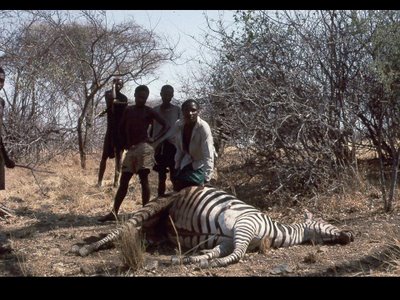 The traditional explanation of this is that Hadza hunters, like many aboriginal people throughout the world, act in a conservatory manner: generally taking only those individuals that no longer contribute to the reproductive potential of herd – in this case, older males that have lost their harems to younger males. In effect, native people like the Hadza are thought to manage game populations through selective harvesting. Turns out, this isn’t the case. While Hadza do tend to take more old adult males from ambush hunting during the dry season (confirmed through dental increment analysis) during other times of the year when hunters encounter them randomly through encounter hunting, they take males, females, old and young in roughly the same proportions as they occur in a living herd. There are a number of things at play here (season, age, herd social dynamics, Hadza hunting technique), but the data suggest that, because of their particular behavior around water holes, male zebra “bachelor” groups tend to be more vulnerable to Hadza hunting techniques. The Hadza are not “selecting” for older male zebra. They are simply taking what is being more readily presented to them in a given situation. In contrast, Hadza hunters take far more female impala while ambush hunting: again, this suggests they do not actively select for specific age and sex classes, but take what is easiest. I have found no data to support the claim that aboriginal people engage in active management of game populations.
The traditional explanation of this is that Hadza hunters, like many aboriginal people throughout the world, act in a conservatory manner: generally taking only those individuals that no longer contribute to the reproductive potential of herd – in this case, older males that have lost their harems to younger males. In effect, native people like the Hadza are thought to manage game populations through selective harvesting. Turns out, this isn’t the case. While Hadza do tend to take more old adult males from ambush hunting during the dry season (confirmed through dental increment analysis) during other times of the year when hunters encounter them randomly through encounter hunting, they take males, females, old and young in roughly the same proportions as they occur in a living herd. There are a number of things at play here (season, age, herd social dynamics, Hadza hunting technique), but the data suggest that, because of their particular behavior around water holes, male zebra “bachelor” groups tend to be more vulnerable to Hadza hunting techniques. The Hadza are not “selecting” for older male zebra. They are simply taking what is being more readily presented to them in a given situation. In contrast, Hadza hunters take far more female impala while ambush hunting: again, this suggests they do not actively select for specific age and sex classes, but take what is easiest. I have found no data to support the claim that aboriginal people engage in active management of game populations.
 The traditional explanation of this is that Hadza hunters, like many aboriginal people throughout the world, act in a conservatory manner: generally taking only those individuals that no longer contribute to the reproductive potential of herd – in this case, older males that have lost their harems to younger males. In effect, native people like the Hadza are thought to manage game populations through selective harvesting. Turns out, this isn’t the case. While Hadza do tend to take more old adult males from ambush hunting during the dry season (confirmed through dental increment analysis) during other times of the year when hunters encounter them randomly through encounter hunting, they take males, females, old and young in roughly the same proportions as they occur in a living herd. There are a number of things at play here (season, age, herd social dynamics, Hadza hunting technique), but the data suggest that, because of their particular behavior around water holes, male zebra “bachelor” groups tend to be more vulnerable to Hadza hunting techniques. The Hadza are not “selecting” for older male zebra. They are simply taking what is being more readily presented to them in a given situation. In contrast, Hadza hunters take far more female impala while ambush hunting: again, this suggests they do not actively select for specific age and sex classes, but take what is easiest. I have found no data to support the claim that aboriginal people engage in active management of game populations.
The traditional explanation of this is that Hadza hunters, like many aboriginal people throughout the world, act in a conservatory manner: generally taking only those individuals that no longer contribute to the reproductive potential of herd – in this case, older males that have lost their harems to younger males. In effect, native people like the Hadza are thought to manage game populations through selective harvesting. Turns out, this isn’t the case. While Hadza do tend to take more old adult males from ambush hunting during the dry season (confirmed through dental increment analysis) during other times of the year when hunters encounter them randomly through encounter hunting, they take males, females, old and young in roughly the same proportions as they occur in a living herd. There are a number of things at play here (season, age, herd social dynamics, Hadza hunting technique), but the data suggest that, because of their particular behavior around water holes, male zebra “bachelor” groups tend to be more vulnerable to Hadza hunting techniques. The Hadza are not “selecting” for older male zebra. They are simply taking what is being more readily presented to them in a given situation. In contrast, Hadza hunters take far more female impala while ambush hunting: again, this suggests they do not actively select for specific age and sex classes, but take what is easiest. I have found no data to support the claim that aboriginal people engage in active management of game populations.But increment data are not just applicable to tropical mammals. I have also been looking at deer teeth from archaeological sites along western slope of the Sierra Nevada in California. 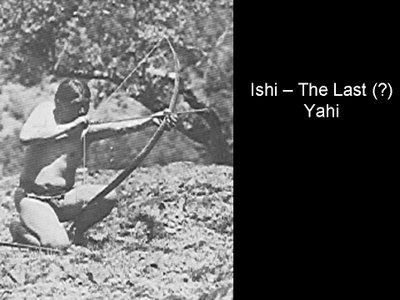 In this region, dental increment data on seasonality and death of large numbers of deer remains (and other data) are forcing a different view of the prehistory. This is the area of Ishi, the lone Yahi who left the rugged “front country” of Mill and Deer Creek drainages in 1911 and entered the world of Euro-Americans, ultimately dying of tuberculosis in Berkeley in 1916. Traditionally, and based largely on the recent ethnographic and historic record of Ishi and the Yahi/Yana Indians (and less on solid archaeological work) the region was assumed to be the traditional homeland of the Yahi/Yana. Therefore, the expectation is that this region will contain village sites and logistical camps associated with a broad spectrum of human activities conducted by males and females of all ages. Conventional wisdom has it that the major rockshelters and midden sites within the area represent village sites and associated activities.
In this region, dental increment data on seasonality and death of large numbers of deer remains (and other data) are forcing a different view of the prehistory. This is the area of Ishi, the lone Yahi who left the rugged “front country” of Mill and Deer Creek drainages in 1911 and entered the world of Euro-Americans, ultimately dying of tuberculosis in Berkeley in 1916. Traditionally, and based largely on the recent ethnographic and historic record of Ishi and the Yahi/Yana Indians (and less on solid archaeological work) the region was assumed to be the traditional homeland of the Yahi/Yana. Therefore, the expectation is that this region will contain village sites and logistical camps associated with a broad spectrum of human activities conducted by males and females of all ages. Conventional wisdom has it that the major rockshelters and midden sites within the area represent village sites and associated activities.
 In this region, dental increment data on seasonality and death of large numbers of deer remains (and other data) are forcing a different view of the prehistory. This is the area of Ishi, the lone Yahi who left the rugged “front country” of Mill and Deer Creek drainages in 1911 and entered the world of Euro-Americans, ultimately dying of tuberculosis in Berkeley in 1916. Traditionally, and based largely on the recent ethnographic and historic record of Ishi and the Yahi/Yana Indians (and less on solid archaeological work) the region was assumed to be the traditional homeland of the Yahi/Yana. Therefore, the expectation is that this region will contain village sites and logistical camps associated with a broad spectrum of human activities conducted by males and females of all ages. Conventional wisdom has it that the major rockshelters and midden sites within the area represent village sites and associated activities.
In this region, dental increment data on seasonality and death of large numbers of deer remains (and other data) are forcing a different view of the prehistory. This is the area of Ishi, the lone Yahi who left the rugged “front country” of Mill and Deer Creek drainages in 1911 and entered the world of Euro-Americans, ultimately dying of tuberculosis in Berkeley in 1916. Traditionally, and based largely on the recent ethnographic and historic record of Ishi and the Yahi/Yana Indians (and less on solid archaeological work) the region was assumed to be the traditional homeland of the Yahi/Yana. Therefore, the expectation is that this region will contain village sites and logistical camps associated with a broad spectrum of human activities conducted by males and females of all ages. Conventional wisdom has it that the major rockshelters and midden sites within the area represent village sites and associated activities.Much of this expectation is severely biased by too great a reliance on Native American ethographies – what is often referred to as the “tyranny of the ethnographic record”. Except for the very late period, dental increment data suggests the region of Ishi was largely used for the seasonal procurement of game (particularly deer) and did not see establishment of major village locations. Dental increment data from a number of sites suggests limited seasonal use of these locations as deer hunting camps. Seasonal signatures from deer tooth increments are commensurate with Hadza kill sites. In other words, the range of seasonal “readings” is very limited and suggests these sites were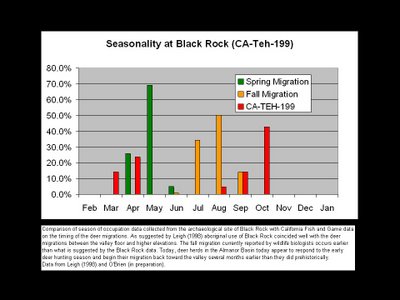 used for very limited duration, unlike village sites, where animals would have been introduced over a longer time frame and reflect a much greater range of seasonal signatures. This is further supported by skeletal part representation at most of these sites – deer skeletal parts are dominated by skulls, backbones and ribs, indicative of the major meat-bearing bones having been transported somewhere else and not consumed onsite. Interestingly, the seasonal ranges reflected in the increment data show two very clear time frames of site use: late fall and early spring. Today the deer herds migrate from higher elevations of the Sierra Nevada to the
used for very limited duration, unlike village sites, where animals would have been introduced over a longer time frame and reflect a much greater range of seasonal signatures. This is further supported by skeletal part representation at most of these sites – deer skeletal parts are dominated by skulls, backbones and ribs, indicative of the major meat-bearing bones having been transported somewhere else and not consumed onsite. Interestingly, the seasonal ranges reflected in the increment data show two very clear time frames of site use: late fall and early spring. Today the deer herds migrate from higher elevations of the Sierra Nevada to the
 used for very limited duration, unlike village sites, where animals would have been introduced over a longer time frame and reflect a much greater range of seasonal signatures. This is further supported by skeletal part representation at most of these sites – deer skeletal parts are dominated by skulls, backbones and ribs, indicative of the major meat-bearing bones having been transported somewhere else and not consumed onsite. Interestingly, the seasonal ranges reflected in the increment data show two very clear time frames of site use: late fall and early spring. Today the deer herds migrate from higher elevations of the Sierra Nevada to the
used for very limited duration, unlike village sites, where animals would have been introduced over a longer time frame and reflect a much greater range of seasonal signatures. This is further supported by skeletal part representation at most of these sites – deer skeletal parts are dominated by skulls, backbones and ribs, indicative of the major meat-bearing bones having been transported somewhere else and not consumed onsite. Interestingly, the seasonal ranges reflected in the increment data show two very clear time frames of site use: late fall and early spring. Today the deer herds migrate from higher elevations of the Sierra Nevada to the In the bar graph above, green and yellow bars indicate timing of the migration for today's deer herd occupying the Ishi Wilderness region of California. Red bars indicate prehistoric timing of the migrations indicated by dental increment data. The earlier summer/fall migration seen today is thought to result from hunting pressure during the current summer archery season, which may be responsible for pushing the deer out of the higher elevations earlier than the prehistoric pattern.
Sacramento Valley in the fall where they remain throughout the winter. In the early spring, the deer reverse the process and migrate back to higher elevation. Dental increment data suggests this patter of migration has been in place in this region for the last 2500 years and is not simply a phenomenon of historic times.
Finally, age data from these sites is suggestive of increasing hunter pressure on deer herds over the last three millennia. Prime-age adult deer comprise a progressively smaller proportion of the deer taken prehistorically beginning about 3000 years ago.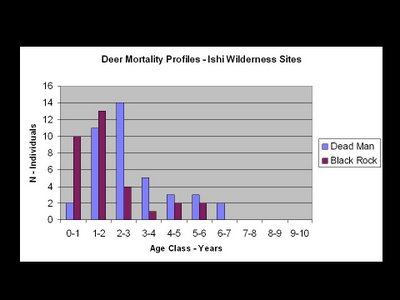 By 500 years ago deer kills are predominately comprised of yearlings and two year olds, suggesting the herd has become largely over-hunted. This is consistent with data suggesting an increasing population of aboriginal people on the landscape during this time and other data which suggests a declining efficiency of taking larger game. It also further dispels any notion of aboriginal people as being wise stewards of the land. Given enough time and larger populations, humans of all cultural backgrounds can take a toll on wild game and will do so if it is in their best interests.
By 500 years ago deer kills are predominately comprised of yearlings and two year olds, suggesting the herd has become largely over-hunted. This is consistent with data suggesting an increasing population of aboriginal people on the landscape during this time and other data which suggests a declining efficiency of taking larger game. It also further dispels any notion of aboriginal people as being wise stewards of the land. Given enough time and larger populations, humans of all cultural backgrounds can take a toll on wild game and will do so if it is in their best interests.
Finally, age data from these sites is suggestive of increasing hunter pressure on deer herds over the last three millennia. Prime-age adult deer comprise a progressively smaller proportion of the deer taken prehistorically beginning about 3000 years ago.
 By 500 years ago deer kills are predominately comprised of yearlings and two year olds, suggesting the herd has become largely over-hunted. This is consistent with data suggesting an increasing population of aboriginal people on the landscape during this time and other data which suggests a declining efficiency of taking larger game. It also further dispels any notion of aboriginal people as being wise stewards of the land. Given enough time and larger populations, humans of all cultural backgrounds can take a toll on wild game and will do so if it is in their best interests.
By 500 years ago deer kills are predominately comprised of yearlings and two year olds, suggesting the herd has become largely over-hunted. This is consistent with data suggesting an increasing population of aboriginal people on the landscape during this time and other data which suggests a declining efficiency of taking larger game. It also further dispels any notion of aboriginal people as being wise stewards of the land. Given enough time and larger populations, humans of all cultural backgrounds can take a toll on wild game and will do so if it is in their best interests.I have necessarily abstracted many of the details regarding dental increment analysis and application, but hopefully this will provide some background on the method. For further reading I recommend the following:
Lieberman, D. E. (1994). The biological basis for seasonal increments in dental cementum and their application to archaeological research. Journal of Archaeological Science 21: 525-39.
Lubinski, P. and C. J. O’Brien (2001). Observations on seasonality and mortality from a recent catastrophic death assemblage. Journal of Archaeological Science 28(8): 833-842.
O’Brien, C. J. (2002). A re-evaluation of dental increment formation in East African mammals: implications for wildlife biology and zooarchaeology. In (Pike-Tay, A. and D. Weinand Eds) Assessing Season of Capture, Age and Sex of Archaeofaunas: Recent Work. University of Victoria, International Council for Zooarchaeology.
O’Brien, C. J. (2001). Seasonality Studies and Deer Teeth: An Introduction to Dental Increment Analysis in California. Society for California Archaeology Newsletter 35(1).
O’Brien, C. J. (1994). Determining Seasonality in East African Archaeological Faunas: An Ethnoarchaeological Application of Cementum Increment Analysis. Doctoral dissertation, Department of Anthropology, University of Wisconsin, Madison.
Pike-Tay, A. (1991). Red Deer Hunting in the Upper Paleolithic of Southwest France: A Study in Seasonality. Oxford: British Archaeological Reports International Series, 569.

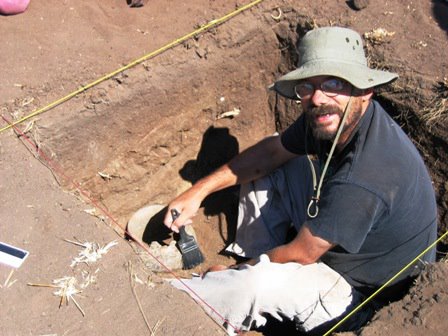


7 comments:
I just read this out-loud to my daughter. She's five. :)
Her only comment was, "what's 'cementum,' daddy?"
Seriously, this is one I'm bookmarking -great info. I had no idea about cementum until now, but I've read other works that noted through their research the exploitive behavior of prehistoric Americans with regard to fauna. I must admit, until then, I had the same assumptions that "Native American" always translates to "environmental steward."
There is a facinating study of Australopithecus (Paranthropus) robustus teeth coming out in Science that you may want to check out...National Geographic also has a write up on it...
"In the inaugural edition of Four Stone Hearth, Afarensis posted on the amazing information even fragments of teeth can provide researchers on evolutionary relationships, diet, and a whole host of additional features of an individual's life history. In the comments to this, Kambiz remarked on another type of tooth analysis that can yield important information on the age of animals at death and provide important insights into prehistoric behavior. It just so happens that much of my graduate research focused on the exact method Kambiz references: dentali increment analysis..." thank for the science as well as the post.
www.onlineuniversalwork.com
rich information thanks
Really effective data, thank you for the article.
The guy is absolutely fair, and there is no suspicion.
Post a Comment